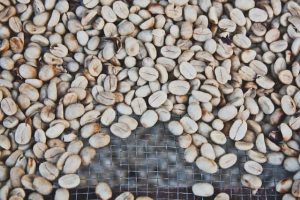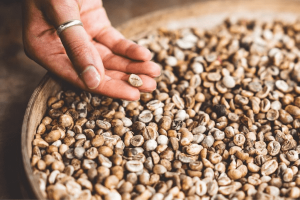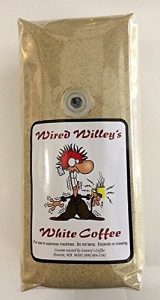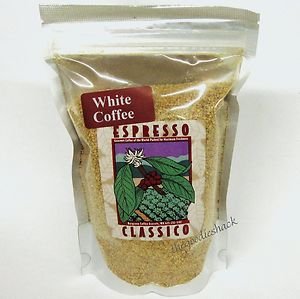What is a White Coffee? A Beginners Quick Roasty Guide: In coffee’s vast and aromatic landscape, one term that might pique the curiosity of enthusiasts and novices alike is “White Coffee.” This beginner’s quick roast guide is your passport to understanding the nuances of this unique coffee variation.
Unveiling the mysteries behind the name, the roasting process, and how it differs from your everyday cup, this guide aims to provide a flavorful introduction to the world of white coffee.
So, whether you’re a seasoned coffee connoisseur or just starting your caffeinated journey, let’s dive into white coffee’s rich and toasty world.
What is a White Coffee? – Unveiling Its Historical Layers

1. Lightly Roasted Coffee:
- Historical Roots: In certain European regions, particularly the United Kingdom, “white coffee” historically referred to coffee made from lightly roasted beans.
- 18th and 19th Centuries: During this period, lightly roasted coffee was favored, resulting in a brew with a lighter color and a distinctive flavor profile characterized by higher acidity and brighter notes.
2. Coffee with Milk or Cream:
- Emergence in the United States: In the United States, especially in diners and traditional coffee shops, “white coffee” took on a different meaning.
- Common Terminology: Ordering a “white coffee” indicated the addition of milk or cream to the coffee, offering a milder and creamier flavor profile.
3. Unroasted Coffee Beans:
- Modern Trends: Contemporary coffee culture has introduced a new interpretation of “white coffee.”
- Unique Preparation: Some enthusiasts and specialty shops use the term to describe coffee made from unroasted or lightly roasted green coffee beans.
- Distinctive Taste: This method produces a unique flavor, often described as more “grassy” or “earthy” than traditionally roasted coffee.
4. Coffee-Flavored Beverage:
- Innovative Approaches: Forward-thinking coffee shops and brands have redefined “white coffee.”
- Beyond Roasting: Some “white coffees” are not made from roasted beans; instead, they involve steeping coffee beans in water without roasting.
- Unique Characteristics: This innovative approach yields a coffee-flavored beverage without the typical roasted flavor, appealing to those seeking a different coffee experience.
Conclusion:
- “white coffee” encapsulates a rich history, adapting to cultural shifts and evolving tastes. From its origins in lightly roasted beans to its incarnation as a creamy coffee option and the modern trend of unroasted coffee, white coffee stands as a testament to the ever-changing landscape of coffee culture. This multifaceted history invites coffee enthusiasts to explore and appreciate the diverse layers of this intriguing brew.
Benefits of White Coffee:
White coffee typically refers to coffee brewed with light or medium-roasted coffee beans and is often prepared with milk or a milk substitute. The term “white coffee” can have different meanings in various contexts, so I’ll cover potential benefits based on different interpretations:
1. Milder Flavor:
-
- Light or medium-roasted coffee beans used in white coffee generally have a milder flavor than dark roasts. This can appeal to those who prefer a coffee with subtler and more nuanced taste notes.
2. Lower Acidity:
-
- Lighter roasts often exhibit lower acidity levels compared to dark roasts. For individuals sensitive to acidity, white coffee might be a gentler option on the stomach.
3. Higher Caffeine Content:
-
- Lighter roasts, commonly used in white coffee, tend to retain more caffeine than dark roasts. This can provide a higher caffeine kick for those who seek a more energizing coffee experience.
4. Versatility:
-
- White coffee is versatile and can be customized according to taste preferences. It can be prepared as a latte, cappuccino, or other milk-based drinks. Adding milk can contribute to a creamier texture and a balanced flavor.
5. Potential Antioxidants:
-
- Coffee, in general, is a rich basis of antioxidants. Antioxidants can have various health benefits, such as neutralizing free radicals in the body.
6. Digestive Comfort:
-
- Some individuals find that combining milk with coffee can help mitigate the potential digestive discomfort associated with black coffee, particularly for those with sensitive stomachs.
7. Customizable Sweetness:
-
- White coffee is often enjoyed with sweeteners or flavored syrups, allowing for a customizable sweetness level based on personal taste preferences.
It’s important to note that while white coffee can offer these potential benefits, individual responses to coffee can vary. Factors such as roast level, bean origin, and preparation methods play a role in the final coffee experience. Additionally, adding milk or sweeteners can contribute to extra calories, so it’s wise to be mindful of overall dietary choices. As with any food or drink, moderation is key to enjoying the potential benefits of white coffee.
The Taste Profile:

The term “white coffee” can have different meanings in various contexts, and it’s essential to clarify that it might be interpreted differently. In the context of coffee with milk or a milk substitute, often associated with lattes or coffee beverages with added creaminess, the taste profile can be influenced by several factors:
1. Milk Creaminess:
-
- Adding milk or a milk substitute contributes a creamy texture to white coffee. This creaminess can soften the overall taste and mouthfeel of the coffee.
2. Sweetness:
-
- White coffee beverages are often enjoyed with sweeteners, flavored syrups, or naturally sweet milk alternatives. The sweetness can vary based on personal preference and the type of sweetener used.
3. Balanced Flavor:
-
- The combination of coffee with milk is designed to create a balanced flavor profile. The milk can help mellow the acidity and bitterness of the chocolate, resulting in a smoother and more approachable taste.
4. Milder Coffee Notes:
-
- Light or medium-roasted coffee beans are commonly used in white coffee, and these roasts tend to have milder and more nuanced flavor notes compared to dark roasts. This can contribute to a gentler coffee taste.
5. Customizable Flavors:
-
- White coffee is highly customizable, allowing individuals to tailor the flavor. Whether it’s through the choice of coffee beans, the type of milk used, or adding flavorings, individuals can create a beverage that suits their taste preferences.
6. Creamy Mouthfeel:
-
- The addition of milk provides a creamy and velvety mouthfeel. This texture enhances the drinking experience, making it more indulgent and satisfying.
7. Versatility:
-
- White coffee’s taste profile is versatile and can be adapted to various preferences. Whether someone enjoys a strong espresso with a dash of steamed milk or a milder coffee with a generous amount of cream, the taste can be adjusted to suit individual preferences.
It’s important to note that taste preferences are highly subjective, and the enjoyment of white coffee can vary from person to person. The specific flavors experienced will depend on factors such as the type of coffee beans used, the roast level, the quality of milk or milk substitute, and any additional flavorings or sweeteners.
How to Make White Coffee?

Making white coffee involves combining coffee with milk or a milk substitute to create a creamy and balanced beverage. Here’s a basic guide on how to make white coffee:
Ingredients:
- Freshly brewed coffee (espresso or strong coffee)
- Milk or milk substitute
- Optional: Sweeteners or flavorings (sugar, honey, vanilla syrup, etc.)
Instructions:
1. Brew Coffee:
-
- Start by preparing a robust cup of coffee. This can be achieved with an espresso machine, a French press, a pour-over method, or any preferred coffee brewing method.
2. Heat Milk:
-
- Heat the milk or milk substitute on the stove or microwave until it reaches your desired temperature. Be careful not to scald the milk.
3. Froth the Milk (Optional):
-
- For an added touch of creaminess, froth the milk using a milk frother, mist wand, or whisk. This step is elective but can enhance the texture of the drink.
4. Combine Coffee and Milk:
-
- Pour the brewed coffee into a cup.
- Slowly add the heated and frothed milk to the coffee. The ratio of coffee to milk can be adjusted based on personal preference.
5. Mix Well:
-
- Stir the coffee and milk together to ensure a consistent blend. This helps distribute the flavors evenly.
6. Optional Sweeteners or Flavorings:
-
- Add sweeteners or flavorings if desired. Common choices include sugar, honey, vanilla syrup, or other flavored syrups.
7. Serve Over Ice (Optional):
-
- If you prefer a cold white coffee, add ice cubes to the glass before pouring the coffee and milk mixture.
8. Garnish (Optional):
-
- Garnish the white coffee with a sprinkle of cinnamon, cocoa powder, or any preferred topping for added flavor and visual appeal.
9. Enjoy:
-
- Your white coffee is now ready to be enjoyed! Sip and savor the creamy and balanced flavors.
Tips:
- Experiment with different types of milk to find the one that suits your taste preferences.
- Adjust the coffee-to-milk ratio to achieve your preferred level of strength.
- Customize the sweetness and flavorings to create your ideal white coffee experience.
Feel free to get creative with your white coffee by exploring different coffee beans, milk alternatives, and flavor combinations to tailor the drink to your liking.
Where to Buy White Coffee Beans?
White coffee beans can be purchased from various sources, both online and in physical stores. Here are several options where you can buy white coffee beans:
1. Local Coffee Roasters:
-
- Visit your local coffee roasters or specialty coffee shops. They often offer a selection of coffee beans, including those suitable for making white coffee. You can ask the staff for references based on your preferences.
2. Online Coffee Retailers:
-
- Numerous online retailers specialize in selling coffee beans. Websites like Amazon, Coffee Bean Direct, and other specialty coffee shops often have a variety of beans to choose from. Look for those labeled as suitable for espresso or light to medium roasts.
3. Supermarkets and Grocery Stores:
-
- Many supermarkets and grocery stores carry a selection of coffee beans. While the variety might not be as extensive as at specialty shops, you can still find suitable light or medium roast beans for white coffee.
4. Coffee Subscription Services:
-
- Consider subscribing to a coffee subscription service that regularly delivers freshly roasted beans to your doorstep. Some services offer curated selections based on your taste preferences.
5. Local Farmers’ Markets:
-
- Explore local farmers’ markets or artisanal food markets. Some coffee roasters and vendors may have booths selling their freshly roasted beans.
6. Direct from Coffee Farms:
-
- Some coffee farms and cooperatives sell their beans directly to consumers. This direct-to-consumer approach ensures freshness and allows you to support specific coffee-producing regions.
7. Health Food Stores:
-
- Health food stores or stores specializing in organic and natural products may carry a selection of high-quality coffee beans, including those suitable for white coffee.
8. Coffee Specialty Shops:
-
- Check with stores that specialize in coffee equipment and accessories. They may also offer a selection of high-quality coffee beans, and the staff can guide the best beans for making white coffee.
When buying white coffee beans, consider factors such as the roast level (light or medium), the origin of the beans, and any specific flavor notes that align with your taste preferences. Reading customer reviews and product descriptions can also provide insights into the characteristics of the beans you are considering.
When choosing to buy white coffee, there are some great, flavorful options available. Here are a few of our top recommended white coffees to choose from:
1. Wired Willey’s White Coffee:

2. Bargreen Espresso Classico White Coffee:

3. Poverty Bay Coffee White Tornado:

Conclusion:
In conclusion, we’ve delved into the world of white coffee in this beginner’s quick guide. From understanding its unique preparation methods to exploring the versatile flavor profiles, white coffee has proven to be a delightful and customizable beverage. Whether you’re a newcomer to the coffee scene or a seasoned enthusiast looking for something new, the charm of white coffee lies in its ability to offer a creamy, balanced experience tailored to individual preferences.
As you embark on your white coffee journey, don’t hesitate to experiment with different coffee beans, milk alternatives, and flavor combinations. The beauty of white coffee is its adaptability, allowing you to create a personalized brew that suits your taste buds perfectly.
Whether you enjoy it hot or over ice, sweetened or pure, white coffee opens up possibilities for coffee lovers seeking a refreshing twist on their caffeine fix. So, grab your favorite beans, froth that milk, and savor the toasty goodness of white coffee—a delightful addition to your coffee repertoire. Here’s to many more creamy cups and caffeinated adventures on your coffee exploration!
FAQs:
Is White Coffee Healthier than Regular Coffee?
Whether white coffee is healthier than regular coffee depends on several factors, including personal health goals, dietary preferences, and how each beverage is prepared. Let’s break down the considerations:
White Coffee:
- Ingredients:
- White coffee typically includes coffee and milk or a milk substitute. The health impact depends on the type of milk used (whole milk, skim milk, almond milk, etc.) and any added sweeteners or flavorings.
- Nutritional Content:
- Milk offers important nutrients like calcium and vitamin D. However, and it also adds calories, and the nutritional profile varies based on the type of milk used.
- Calories:
- Adding milk and potential sweeteners increases the calorie content of white coffee compared to black coffee.
Regular (Black) Coffee:
- Low in Calories:
- Black coffee, without added cream, sugar, or milk, is very low in calories. It’s a calorie-free beverage and a good choice for minimizing calorie intake.
- Antioxidants:
- Coffee is rich in antioxidants, which have potential health profits, such as protecting cells from damage caused by free radicals.
- Caffeine:
- Coffee offers a natural source of caffeine, which can temporarily boost alertness and mood.
Considerations:
- Caloric Intake:
- If weight management is a concern, the added calories from milk and any sweeteners in white coffee should be considered.
- Nutrient Profile:
- White coffee with milk can contribute to nutrient intake, especially using fortified milk varieties. However, excessive consumption of certain nutrients (like saturated fat) may be a consideration.
- Dietary Preferences:
- Alternative milk choices can be used in white coffee for those with lactose intolerance or a preference for plant-based options.
- Blood Sugar Impact:
- Sweetened white coffee can impact blood sugar levels, making it a consideration for individuals managing conditions like diabetes.
Verdict:
In terms of pure coffee content, white and black coffee offer potential health benefits. However, adding milk and sweeteners to white coffee increases its caloric and nutritional content, which may or may not align with specific health goals.
If weight management is a priority, and you enjoy the health benefits of coffee without additional calories, black coffee may be preferable. If you appreciate the creaminess and added nutrients from milk, choosing lower-fat milk options or plant-based alternatives can be a healthier option.
As with any dietary choice, moderation and awareness of individual health considerations are essential. It’s advisable to consult with a healthcare expert or a registered dietitian to determine the best coffee choice based on your specific health needs and goals.
Does White Coffee Have More Caffeine?
The caffeine content in white coffee depends on the type of chocolate beans used and the coffee-to-milk ratio. Generally, the caffeine level in white coffee is similar to that in black coffee made from the same type of beans. Here are some key points to consider:
Factors Affecting Caffeine Content:
- Coffee Beans:
- The type of coffee beans used, and their origin influence caffeine content. Robusta beans generally contain more caffeine than Arabica beans.
- Roast Level:
- Lighter roasts generally retain slightly more caffeine than darker roasts. White coffee is often made with light or medium-roasted beans.
- Brewing Method:
- The brewing method (espresso, drip, etc.) can impact caffeine extraction. Espresso, commonly used in white coffee, tends to have a higher attentiveness of caffeine per ounce.
- Coffee-to-Milk Ratio:
- The proportion of coffee to milk in white coffee can vary. The caffeine content per serving will be higher if there is a higher coffee-to-milk ratio.
Comparable to Black Coffee:
The caffeine content should be comparable if the same type of coffee beans is used in white and black coffee, and the brewing method and coffee-to-water ratio are similar.
Caffeine Content in Common Coffee Types:
- Espresso:
- Espresso, a common component of white coffee, has a higher caffeine concentration per ounce than regular brewed coffee.
- Drip Coffee:
- A standard cup (8 ounces) of drip-brewed coffee generally include more caffeine than a shot of espresso, but the concentration is lower.
- White Coffee:
- The caffeine content in white coffee will depend on the factors mentioned earlier. If it’s made with a higher coffee-to-milk ratio and uses espresso as a base, it could have a higher caffeine concentration than a standard cup of black coffee.
Moderation is Key:
Regardless of the coffee type chosen, consuming caffeine in moderation is essential. Individual tolerance, sensitivity, and overall health should be considered. If you have specific concerns about caffeine intake, it’s advisable to consult with a healthcare expert.

